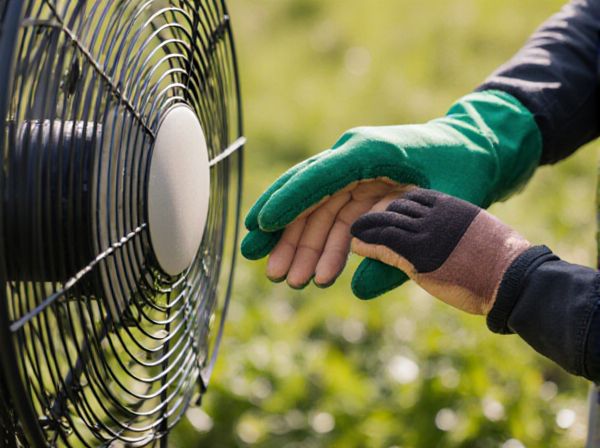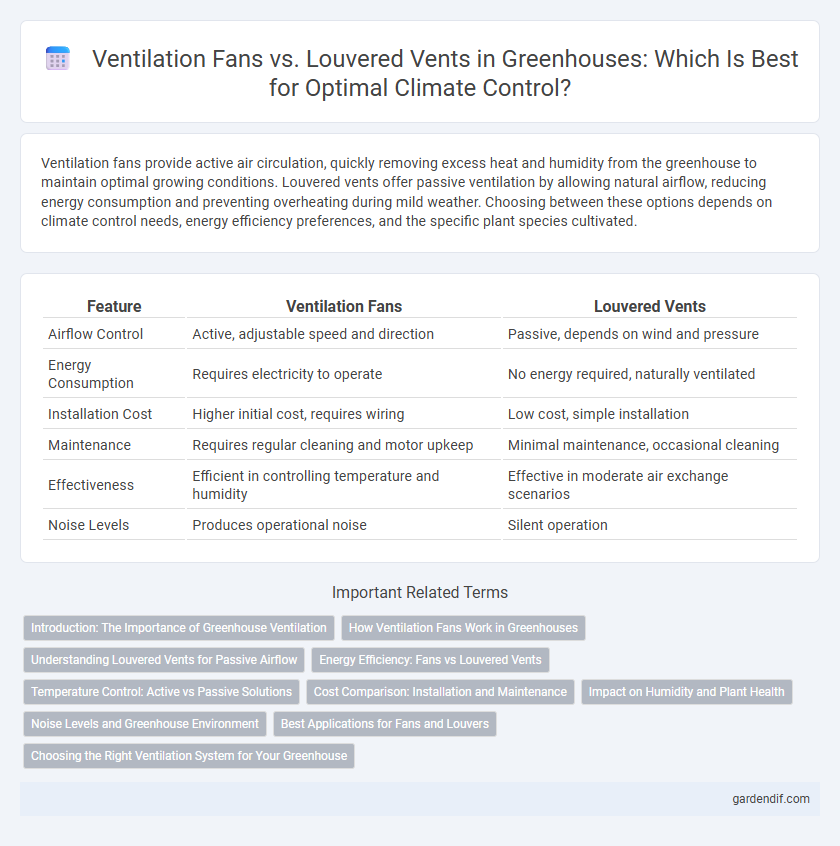
Ventilation Fans vs Louvered Vents Illustration
Ventilation fans provide active air circulation, quickly removing excess heat and humidity from the greenhouse to maintain optimal growing conditions. Louvered vents offer passive ventilation by allowing natural airflow, reducing energy consumption and preventing overheating during mild weather. Choosing between these options depends on climate control needs, energy efficiency preferences, and the specific plant species cultivated.
Table of Comparison
| Feature | Ventilation Fans | Louvered Vents |
|---|---|---|
| Airflow Control | Active, adjustable speed and direction | Passive, depends on wind and pressure |
| Energy Consumption | Requires electricity to operate | No energy required, naturally ventilated |
| Installation Cost | Higher initial cost, requires wiring | Low cost, simple installation |
| Maintenance | Requires regular cleaning and motor upkeep | Minimal maintenance, occasional cleaning |
| Effectiveness | Efficient in controlling temperature and humidity | Effective in moderate air exchange scenarios |
| Noise Levels | Produces operational noise | Silent operation |
Introduction: The Importance of Greenhouse Ventilation
Effective greenhouse ventilation is essential for regulating temperature, humidity, and air quality to promote optimal plant growth. Ventilation fans provide powerful, controlled air exchange, quickly removing excess heat and moisture. Louvered vents offer passive airflow, allowing natural ventilation and reducing energy consumption for sustainable greenhouse management.
How Ventilation Fans Work in Greenhouses
Ventilation fans in greenhouses operate by actively circulating air to regulate temperature, humidity, and CO2 levels, promoting optimal plant growth. These fans pull hot, stale air out while drawing cooler, fresh air in, creating a controlled environment that prevents overheating and reduces disease risk. Unlike passive louvered vents, ventilation fans provide consistent airflow regardless of external wind conditions, ensuring uniform climate control inside the greenhouse.
Understanding Louvered Vents for Passive Airflow
Louvered vents enable passive airflow in greenhouses by allowing natural air exchange without mechanical assistance, promoting energy efficiency. These vents feature angled slats that prevent rain and debris while maintaining consistent ventilation to regulate temperature and humidity levels. Unlike ventilation fans, louvered vents rely on wind and thermal convection, making them ideal for sustainable climate control in plant-growing environments.
Energy Efficiency: Fans vs Louvered Vents
Ventilation fans in greenhouses actively circulate air, enhancing temperature control but consuming significant electricity, impacting energy efficiency. Louvered vents rely on natural airflow for passive ventilation, minimizing energy use and lowering operational costs. Balancing ventilation needs with energy consumption depends on greenhouse size, climate, and crop requirements.
Temperature Control: Active vs Passive Solutions
Ventilation fans provide active temperature control by continuously circulating air and expelling hot, stale air, ensuring a consistent internal environment in the greenhouse. Louvered vents offer a passive solution by allowing natural airflow based on external wind and temperature differences, reducing energy consumption but resulting in less precise temperature regulation. Combining both systems can optimize climate control, balancing energy efficiency with effective temperature management.
Cost Comparison: Installation and Maintenance
Ventilation fans in greenhouses generally require higher initial installation costs due to electrical components and wiring compared to louvered vents, which are simpler and more affordable to install. Maintenance expenses for ventilation fans include periodic motor servicing and potential replacement parts, while louvered vents demand minimal upkeep, mostly occasional cleaning and lubrication. Choosing between these options depends on balancing upfront investment with long-term operational costs and climate control efficiency.
Impact on Humidity and Plant Health
Ventilation fans actively regulate humidity by enhancing air circulation, crucial for preventing fungal diseases and promoting optimal plant transpiration in greenhouses. Louvered vents provide passive airflow, which can be insufficient in high humidity conditions, potentially leading to moisture buildup and increased risk of mold. Effective humidity control through ventilation fans supports healthier plant growth by maintaining stable moisture levels and reducing stress caused by excessive humidity.
Noise Levels and Greenhouse Environment
Ventilation fans in greenhouses typically generate higher noise levels, which can stress plants and disrupt beneficial insect activity, whereas louvered vents operate silently, maintaining a quieter environment conducive to optimal plant growth. The continuous airflow from fans ensures rapid temperature and humidity control but may increase noise pollution inside the greenhouse, affecting worker comfort and pollinator presence. Louvered vents provide passive ventilation that stabilizes airflow with minimal sound, promoting a natural growing environment by reducing temperature fluctuations and preserving pollinator habitats.
Best Applications for Fans and Louvers
Ventilation fans are ideal for controlling temperature and humidity in larger greenhouses where active air circulation is necessary to maintain optimal growing conditions. Louvered vents work best in smaller or passive ventilation systems by allowing natural airflow and reducing the risk of pests while minimizing heat loss. Combining fans with louvered vents enhances airflow efficiency, balancing mechanical and passive ventilation for varied greenhouse environments.
Choosing the Right Ventilation System for Your Greenhouse
Ventilation fans provide active air circulation by expelling warm air and drawing in cooler air, making them ideal for temperature control in larger or enclosed greenhouses. Louvered vents offer passive ventilation by allowing natural airflow through adjustable openings, which is energy-efficient but depends on external wind conditions. Selecting the right system depends on the greenhouse size, climate, and desired control level; combining both can optimize airflow and maintain optimal growing conditions.
Ventilation Fans vs Louvered Vents Infographic

 gardendif.com
gardendif.com